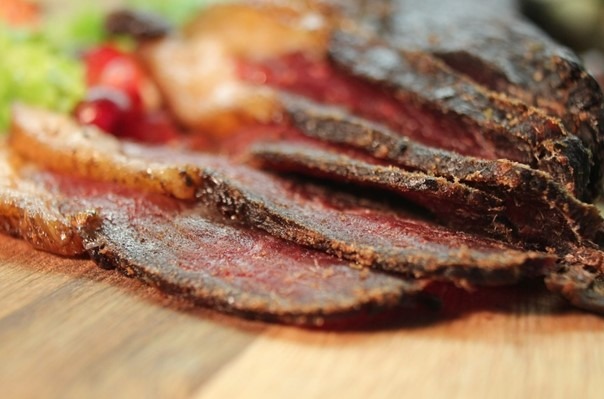
How to Make the Best Beef Jerky From Home
Store-bought jerky can be a convenient protein source, but have you ever considered making your own? Not only is it surprisingly easy, but it also allows you to control the ingredients, customize the flavors, and potentially save some money. From classic cowboys’ snacks to gourmet flavor explosions, there’s a world of jerky waiting to be explored right in your own kitchen.
Choosing Your Beef: The Foundation for Flavorful Jerky
The first step to making the best beef jerky is selecting the right cut of beef. Lean cuts with minimal fat are ideal, as fat can turn rancid during storage. Flank steak, eye of round, and top round are all excellent choices. Once you’ve chosen your cut, trim away any excess fat. Then, it’s time to slice the beef against the grain (think perpendicular to the muscle fibers) into thin strips – around ¼ inch thick is ideal. This ensures even drying and easier chewing later.
Marinating Magic to Unlock Flavor Potential
While not essential, marinating your beef strips adds a whole new dimension of flavor to your jerky. Marinades work their magic by tenderizing the meat and infusing it with delicious flavors. Popular marinade ingredients include soy sauce, Worcestershire sauce, liquid smoke, brown sugar, and your favorite spices. For a classic jerky flavor, try a marinade of soy sauce, Worcestershire sauce, brown sugar, garlic powder, and onion powder. Feeling adventurous? Get creative with bolder options like sriracha, chipotle peppers, or even teriyaki sauce. Simply combine your chosen ingredients in a non-reactive container (think glass or stainless steel) and marinate your beef strips for at least 6 hours, or preferably overnight, in the refrigerator.
For those who prefer a simpler approach, dry rubs are a great alternative. Combine your favorite spices, like chili powder, garlic powder, onion powder, and smoked paprika, and coat your beef strips in the rub before dehydrating. Dry rubs offer a more subtle flavor compared to marinades but still add a delicious depth to your jerky.
Transforming Beef into Jerky
Now comes the fun part – the actual dehydration process! The most common method for dehydrating jerky is using a dehydrator. These handy appliances circulate warm air at a low temperature (around 160°F to 165°F) to gently dry your food without compromising its nutritional value. Most dehydrators come with adjustable temperature settings, so be sure to consult your specific model’s instructions. Drying time will vary depending on the thickness of your beef strips and your dehydrator’s wattage, but typically takes 6-8 hours.
Don’t have a dehydrator? Don’t worry! You can still make delicious beef jerky using your oven. Set your oven to its lowest possible temperature setting (ideally around 170°F) and keep the oven door slightly ajar to allow moisture to escape. This method requires more attention, as you’ll need to rotate the beef strips frequently to ensure even drying. Oven drying can also take significantly longer than using a dehydrator, so be prepared for a waiting game. Important safety note: When dehydrating with your oven, it’s crucial to monitor the temperature closely to avoid overheating, which could be a fire hazard.
Knowing When Your Jerky is Done: The Art of Perfect Texture
Once your jerky has been dehydrating for several hours, it’s time to check for doneness. Perfectly dried jerky should be leathery and flexible, not brittle. You shouldn’t see any visible moisture on the surface, and when you bend a piece of jerky, it should bend slightly but then snap back into shape without tearing.
Here’s an important safety tip: Regardless of your dehydration method, it’s crucial to reach a safe internal temperature of 160°F throughout the jerky to ensure it’s free of harmful bacteria. Use a food thermometer to check the temperature of your jerky in several places before enjoying it.
Storing Your Homemade Jerky
Once your jerky is completely cool and dry to the touch, it’s time for proper storage. Airtight containers are essential to prevent moisture from returning and spoiling your jerky. Mason jars or vacuum-sealed bags are excellent options. For an extra layer of protection against oxidation, consider adding oxygen absorbers to your storage container. These little packets absorb oxygen, further extending the shelf life of your dehydrated snacks.
Properly stored, homemade jerky can last for several months at room temperature. If you plan on storing your jerky for an extended period, consider keeping it in the refrigerator for optimal freshness.
Recipe Ideas to Spark Your Creativity
Ready to put your jerky-making skills to the test? Here are a couple of recipe ideas to get you started:
- Classic Beef Jerky: This simple marinade uses a combination of soy sauce, Worcestershire sauce, brown sugar, garlic powder, and onion powder to create a savory jerky with a touch of sweetness.
- Spicy Sriracha Beef Jerky: Love a kick? This recipe incorporates sriracha sauce, chili flakes, and smoked paprika for a jerky with a fiery flavor.
These are just a jumping-off point, of course! Don’t be afraid to experiment with different marinades and spice combinations to create jerky that reflects your personal preferences. Think teriyaki for a hint of Asian flair, or go bold with a black pepper and cracked coriander blend for a truly unique flavor profile.
Conclusion: The Satisfaction of Homemade Jerky
Making your own jerky is a rewarding experience. Not only do you get to control the ingredients and customize the flavors, but you also get the satisfaction of creating a delicious and healthy snack from scratch. So, the next time you’re craving jerky, skip the store-bought options and give homemade a try. You might just surprise yourself with your jerky-making skills!
Extra Tips
Common Jerky-Making Problems:
- Jerky is Too Tough: If your jerky is rock-hard, it might have been over-dried. Pay close attention to drying times and internal temperature to avoid this. Additionally, consider using slightly thicker cuts of beef (around ½ inch) for a chewier texture.
- Jerky Isn’t Dry Enough: Not dry enough jerky can spoil quickly. Ensure your dehydrator or oven is set to the correct temperature and that there’s adequate airflow.
Advanced Techniques: Smoking for Extra Flavor:
For an extra layer of smokiness, consider using a smoker to finish your jerky. This adds a delicious campfire-like flavor that will take your homemade jerky to the next level. There are various smoker models available, so be sure to research techniques specific to your smoker.
With a little practice and exploration, you’ll be well on your way to jerky mastery, creating delicious and satisfying snacks that are perfect for on-the-go adventures or simply enjoying at home.

